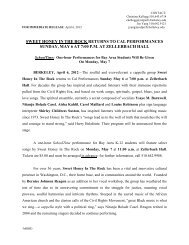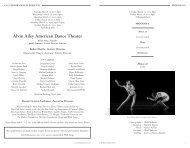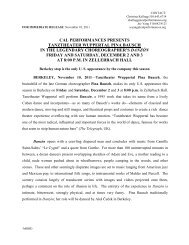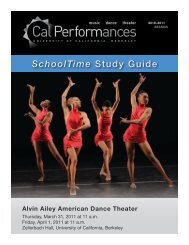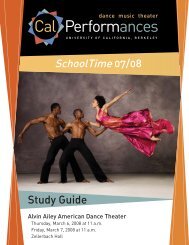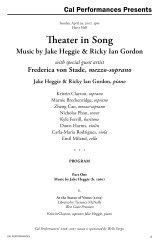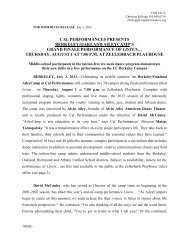Les Ballets Trockadero de Monte Carlo - Cal Performances
Les Ballets Trockadero de Monte Carlo - Cal Performances
Les Ballets Trockadero de Monte Carlo - Cal Performances
You also want an ePaper? Increase the reach of your titles
YUMPU automatically turns print PDFs into web optimized ePapers that Google loves.
CAL PERFORMANCES PRESENTS<strong>Les</strong> <strong>Ballets</strong> <strong>Trocka<strong>de</strong>ro</strong> <strong>de</strong> <strong>Monte</strong> <strong>Carlo</strong>Thursday-Saturday, May 5-7, 2005, 8 pmZellerbach HallFeaturingIrina Bakpakova Fifi Barkova Ludmila BeaulemovaSylphia Belchick Lariska Dumbchenko Sveltlana Lofatkina Margeaux Mun<strong>de</strong>ynVera Namethatunenova Ida Nevasayneva Maria Paranova Nadja RombovaAlla Snizova Olga Supphozova Gerd TordYakatarina Verbosovich Doris VidanyaandJacques d’Ambrosia Jacques d’Aniels Roland DeaulinPepe Dufka Nicholas KhachafallenjarMarat Legupski Nikolai Legupski Vladimir LegupskiMedulli Lobotomov R.M. (“Prince”) Myshkin Velour PilleauxIgor Slowpokin Yuri Smirnov Pavel TordZapoi Valenki William VanillaLa VivandiereEugene McDougleTory DobrinPamela PribiscoIsabel Martinez Riverageneral directorartistic directorballet mistressassociate directorCAL PERFORMANCES5
PROGRAM<strong>Les</strong> <strong>Ballets</strong> <strong>Trocka<strong>de</strong>ro</strong> <strong>de</strong> <strong>Monte</strong> <strong>Carlo</strong>Thursday-Saturday, May 5-7, 2005, 8 pmZellerbach HallPROGRAMLe Lac Des Cygnes (Swan Lake, Act Ii)Music by Pyotr Ilyich TchaikovskyChoreography after Lev Ivanovich IvanovCostumes by Mike GonzalesDecor by Jason CoursonLighting by Kip MarshSwept up into the magical realm of swans (and birds), this elegiac phantasmagoria of variations an<strong>de</strong>nsembles in line and music is the signature work of <strong>Les</strong> <strong>Ballets</strong> <strong>Trocka<strong>de</strong>ro</strong>. The story of O<strong>de</strong>tte, thebeautiful princess turned into a swan by the evil sorcerer, and how she is nearly saved by the love ofPrince Siegfried, was not so unusual a theme when Tchaikovsky first wrote his ballet in 1877 – themetamorphosis of mortals into birds and vice versa occurs frequently in Russian folklore. The originalSwan Lake at the Bolshoi Theatre in Moscow was treated unsuccessfully; a year after Tchaikovsky’s<strong>de</strong>ath in 1893, the St. Petersburg Mariinsky Ballet produced the version we know today. Perhaps theworld’s best known ballet, its appeal seems to stem from the mysterious and pathetic qualities of theheroine juxtaposed with the canonized glamour of 19th century Russian ballet.Benno Igor Slowpokin(friend and confidant to)Prince Siegfried Pavel Tord(who falls in love with)O<strong>de</strong>tte Sveltlana Lofatkina(Queen of the)SwansIrina Bakpakova, Ludmila Beaulemova, Margeaux Mun<strong>de</strong>yn,Vera Namethatunova, Maria Paranova, Alla Snizova, Doris Vidanya,Yakatarina Verbosovich(all of whom got this way because of)Von Rothbart Velour Pilleaux(an evil wizard who goes about turning girls into swans)INTERMISSIONPas <strong>de</strong> Deux or solo to be announcedLa VivandierePas <strong>de</strong> SixMusic by Cesare PugniChoreography by Arthur Saint LeonStaged by Elena Kunikova6CAL PERFORMANCES
PROGRAMCostumes by Mike GonzalesDecor by Jason CoursonLighting by Tricia ToliverThis excerpt from La Vivandiere, a ballet in one act with a libretto and choreography by Arthur SaintLeon, was first presented in May 1844 at Her Majesty’s Theatre in London, starring the celebratedItalian ballerina, Fanny Cerrito. The ballet is set in a little village in Hungary, where Kathi, a campfollower, loves and dances with Hans, the son of a tavern keeper. This ballet became famous as itintroduced the Redowa, the original Polka of Bohemia, to 19 th -century London.Nadja RombovaIgor SlowpokinwithCorps <strong>de</strong> BalletThe Dying SwanMusic by Camille Saint-SaensChoreography after Michel FokineCostume by Mike GonzalesFokine had little notion when he created this solo for Anna Pavlova in 1905 that it would become, inlater years, her signature dance–and perhaps the most famous solo in ballet. The <strong>Trocka<strong>de</strong>ro</strong> offers itsown distinctive interpretation of the terminal fowl.Ida NevasaynevaINTERMISSIONRaymonda’s WeddingA Traditionally Confusing Divertissement In Two ScenesMusic by Alexan<strong>de</strong>r GlazunovChoreography after Marius PetipaCostumes by Mike Gonzales and Ken BusbinDecor by Chas. B. SlackmanLighting by Kip MarshRaymonda, a ballet in three acts and 15 scenes, based on the scenario by L. Pashkova, has baffledaudiences since its premiere at the Mariinsky (then Kirov, now Mariinsky) Theater in 1898. The plot,which loses something in translation, is as follows:Count Jean <strong>de</strong> Brienne (a knight), betrothed to Raymonda (a young Hungarian noblewoman),abandons her to join the Crusa<strong>de</strong>s against the Saracens. In his absence, Abdourahman (a Saracen Emir),woos Raymonda. When she rejects him, he attempts to abduct her. De Brienne, assisted by The WhiteLady (Raymonda’s Fairy Godmother), slays Abdourahman and marries Raymonda. The <strong>Trocka<strong>de</strong>ro</strong>ignores all of these plot intrigues and presents the happy ending.CAL PERFORMANCES7
PROGRAMScene 1The entrance of the bri<strong>de</strong>smaids and their <strong>de</strong>parture for the wedding.Scene 2The reception.The White Lady Alla Snizova(Left over from Acts 1 and 2, she is sometimes a statue, sometimes a ghost,always an enigma)Bri<strong>de</strong>smaidsMagda Sveltlana LofatkinaClemence Sylphia BelchickHortense Nadja RombovaStefanie Olga SupphozovaFriends of the GroomAnais and Francois Doris Vidanya and Jacques d’AmbrosiaFifi and Philippe Fifi Barkova and Vladimir LegupskiZsa Zsa and Laslo Gerd Tord and Pavel TordLudmilla and Zoltan Margeaux Mun<strong>de</strong>yn and Zapoi ValenkiThe Bri<strong>de</strong>Raymonda Lariska DumbchenkoThe GroomCount Jean <strong>de</strong> Brienne Marat Legupski<strong>Les</strong> <strong>Ballets</strong> <strong>Trocka<strong>de</strong>ro</strong> De <strong>Monte</strong> <strong>Carlo</strong>, Inc. is a nonprofit dance company chartered by the State of NewYork. Eugene McDougle, presi<strong>de</strong>nt, Lucille Lewis Johnson, vice-presi<strong>de</strong>nt, Tory Dobrin, secretary/treasurer.Program subject to change without notice.Special thanks to: The Harkness Foundations for Dance, Theodore S. Bartwink, Elena Kunikova and DavidArchuletta, Emily Rybinski, Nancy Gabriel, Julia Glawe and Gillian Newson of IMG Artists.Music for Swan Lake, Go for Barocco conducted by Pierre Michel Durandwith the Czech Philharmonic Chamber Orchestra, Pavel Prantl, Lea<strong>de</strong>rExclusive Worldwi<strong>de</strong> Representation by:IMG ArtistsCarnegie Hall Tower152 West 57th Street, 5th FloorNew York, NY 10019Phone: 212-994-3500 Fax: 212-994-35508CAL PERFORMANCES
ABOUT THE ARTISTS<strong>Les</strong> <strong>Ballets</strong> <strong>Trocka<strong>de</strong>ro</strong> De <strong>Monte</strong> <strong>Carlo</strong> wasfoun<strong>de</strong>d in 1974 by a group of ballet enthusiastsfor the purpose of presenting a playful, entertainingview of traditional, classical ballet in parody formand en travesti, first performed in the late-lateshows in off-off broadway lofts. The Trocks, as theyare affectionately known, quickly garnered a majorcritical essay by Arlene Croce in The New Yorker, andthis combined with reviews in The New York Timesand The Village Voice established the company asan artistic and popular success. By mid 1975, theTrocks’ inspired blend of their loving knowledge ofdance, their comic approach, and the astoundingfact that men can, in<strong>de</strong>ed, dance en pointe withoutfalling flat on their faces, was being noted beyondNew York. Articles and notices in publicationssuch as Variety, Oui, The London Daily Telegraph,as well as a Richard Avedon photo essay in Vogue,ma<strong>de</strong> the company nationally and internationallyknown.The 1975-76 season was a year of growthand full professionalization. The companyfound management, qualified for the NationalEndowment for the Arts touring program, andhired a full-time teacher and ballet mistress tooversee daily classes and rehearsals. Also in thisseason, they ma<strong>de</strong> their first exten<strong>de</strong>d tours of theUnited States and Canada–packing, unpacking,and repacking tutus and drops; stocking giantsizedtoe shoes by the case; running for planes andchartered buses all became routine parts of life.Since those beginnings, the Trocks haveestablished themselves as a major dancephenomenon throughout the world. They haveparticipated in dance festivals in Holland, Madrid,New York, Paris, Spoleto, Turin, and Vienna.There have been television appearances as varied asa Shirley Maclaine special, the Dick Cavett Show,What’s My Line?, Real People, On-Stage America,with Kermit and Miss Piggy on their show MuppetBabies, and a BBC Omnibus special on the worldof ballet hosted by Jennifer Saun<strong>de</strong>rs. In addition,they have had their own solo specials on nationalnetworks in Japan and Germany, as well as aFrench television special with Julia Migenes. Adocumentary was filmed and aired internationallyby the acclaimed British arts program, The SouthBank Show, and the company was featured inthe PBS program The Egg, about arts in America.Several performances were taped by a consortiumof Dutch, French and Japanese TV networks at theMaison <strong>de</strong> la Danse in Lyon, France, for worldwi<strong>de</strong>broadcast and DVD distribution.The Trocks’ numerous tours have been bothpopular and critical successes—their frenziedannual schedule has inclu<strong>de</strong>d five tours to Australiaand New Zealand, 20 to Japan (where theirannual summer tours have created a nationwi<strong>de</strong>cult following and a fan club), eight to SouthAmerica, three tours to South Africa, and 41 toursof Europe. In the US, the company has becomea regular part of the college and university circuitin addition to regular dance presentations in citiesthroughout 48 of the 50 states. The company hasappeared in more than 500 cities worldwi<strong>de</strong> sinceits founding in 1974. Increasingly, the companyis presenting longer seasons, which have inclu<strong>de</strong><strong>de</strong>xten<strong>de</strong>d engagements in Amsterdam, Barcelona,Beijing, Berlin, Buenos Aires, Caracas, Cologne,Hamburg, Hong Kong, Johannesburg, Lisbon,London, Lyon, Madrid, Melbourne, Singapore,Sydney, and Vienna. The 30th anniversary ofthe Trock’s during the 2005 season builds on thesuccess of the past. The company’s worldwi<strong>de</strong> tourinclu<strong>de</strong>s performances in the Far East (China,Japan, Singapore, Thailand), Europe (France,Poland, Portugal, Russia (including performancesat the Bolshoi theater), and Spain and all across theUS, including a sold-out and critically acclaimedseason at the Joyce Theater in New York City.The company continues to appear in benefitsfor international AIDS organizations such as DRA(Dancers Responding to AIDS) and ClassicalAction in New York City, the Life Ball in Vienna,Austria, Dancers for Life in Toronto, Canada,and London’s Stonewall Gala. In addition, theTrocks have given, or participated in specialbenefit performances for Rochester City Ballet,Connecticut Ballet Theater, and the Gay and<strong>Les</strong>bian Community Center in New York City.The original concept of <strong>Les</strong> <strong>Ballets</strong> <strong>Trocka<strong>de</strong>ro</strong><strong>de</strong> <strong>Monte</strong> <strong>Carlo</strong> has not changed since itsinception. It is a company of professional maledancers performing the full range of the ballet andmo<strong>de</strong>rn dance repertoire, including classical andoriginal works in faithful renditions of the mannersand conceits of those dance styles. The comedy isachieved by incorporating and exaggerating thefoibles, acci<strong>de</strong>nts, and un<strong>de</strong>rlying incongruitiesof serious dance. The fact that men dance all theparts—heavy bodies <strong>de</strong>licately balancing on toes asswans, sylphs, water sprites, romantic princesses,angst-rid<strong>de</strong>n Victorian ladies—enhances ratherthan mocks the spirit of dance as an art form,CAL PERFORMANCES9
ABOUT THE ARTISTS<strong>de</strong>lighting and amusing the most knowledgeable,as well as novices, in the audience. For the future,there are plans for new works in the repertoire;new cities, states, and countries to perform in;and for the continuation of the Trocks’ originalpurpose: To bring the pleasure of dance to thewi<strong>de</strong>st possible audience. They will, as they havedone for 30 years, “Keep on Trockin’.”MEET THE ARTISTSIrina Bakpakova. Any ballet goer who sawIrina Bakpakova dancing on a herring in herfirst American tour is not likely to forget heroutstanding performance as the Sour CreamFairy. One of the world’s great dialectical sophists,Honored Artist Bakpakova came to the stage fromthe Volga-Dnieper School of Dance Polemics whereshe excelled in lyric parts and tableaux vivifies.There she gained youthful fame as a practitionerof barefoot naturalism right up to the eyebrows.Following her graduation she was drafted by the<strong>Trocka<strong>de</strong>ro</strong> for a player to be named later.Fifi Barkova. The secrets of Fifi Barkova’sbeginnings lie shrou<strong>de</strong>d behind the Kremlin wall.In fact, no fewer than six lie in the wall (in jarsof assorted sizes). Dancing lightly over pogromsand other sordid reorganizational measures, Mlle.Barkova has emerged as a ballerina nonpareil whosepungency is indisputable. Among her colleagues inthe West, she is known as the O<strong>de</strong>ssa Chihuahua.Ludmila Beaulemova. A born-again ballerina,who, after having strayed from the path, has<strong>de</strong>ci<strong>de</strong>d to return to the stage with the <strong>Trocka<strong>de</strong>ro</strong>.Realizing that the glamour and glitter of rehearsalstudios, calluses, blisters, and bunions are far morerewarding than the drudgery of ordinary life, shehas once again taken the vow of the plie, the tondueand the toe shoe.Sylphia Belchick. A celebrated child prodigyback in the Brezhnev era, Sylphia Belchickastoun<strong>de</strong>d her parents at the age of 2 by taking acorrespon<strong>de</strong>nce course in ballet. Sadly, due to theunreliable Russian postal system, she has only justgraduated.Lariska Dumbchenko. Before <strong>de</strong>fecting tothe West, Lariska’s supreme agility aroused theinterest of the Russian space program, and in1962 she became the first ballerina to be shotinto orbit. Hurtling through the stratosphere, she<strong>de</strong>livered handy make-up tips to an assembledcrowd of celebrities back on Earth, including thenow legendary...“Whitney Houston, we have aproblem....”Sveltlana Lofatkina. Lyrical, lissome, long-leggedSveltlana, “The Chernobyl Cherub,” has producedfrissons in audiences on every continent but twowith her ineffable <strong>de</strong>licacy and refinement. Thislimber gamine has captivated hearts since herauspicious <strong>de</strong>but as Talyusha, the Left Nostril, inthe ballet drawn from The Nose by N. Gogol. Sheis renowned for her portrayal of sensitive torturedneurotic ladies and other kvetches.Margeaux Mun<strong>de</strong>yn, originally a dresser to a greatballerina, began her career when, one night, shelocked her mistress in the armoire and danced in herplace. Although hailed by critics for her won<strong>de</strong>rfultechnique, she fooled no one. She was immediatelysought after by companies and impresarios alike,but <strong>de</strong>ci<strong>de</strong>d instead to spend some time on heracting. Now she is both a technical and a dramaticballerina. The whereabouts of her former mistressare not known.Vera Namethatunenova was discovered by kindlypeasants, adrift in a basket on the river Neva. Her<strong>de</strong>but at the Mariinsky Theatre, St. Petersburg, wasmarred by her overzealous grand jeté into the Tsar’sbox, impaling a Grand Duchess. Banished fromRussia, she ma<strong>de</strong> her way arduously to New York,where she foun<strong>de</strong>d, and still directs, the Ecole <strong>de</strong>Ballet <strong>de</strong> Hard-Nox. Her most famous exerciseis the warm-up consisting of a martini and anelevator.Ida Nevasayneva, socialist Real ballerina of theworking peoples everywhere, comes flushed fromher triumphs at the Varna Festival, where she wasawar<strong>de</strong>d a specially created plastic medal for BadTaste. Comra<strong>de</strong> Ida became known as a heroineof the Revolution when, after effortlessly boureeingthrough a mine field, she lobbed a loa<strong>de</strong>d toeshoeinto a capitalist bank.Maria Paranova’s remarkable life story, only nowcoming to light after 19 dark years in near hopelessconviction that she was Mamie Eisenhower, willnever fully be told. The discovery of her true10CAL PERFORMANCES
ABOUT THE ARTISTSi<strong>de</strong>ntity (at a Republican fundraiser in Chicago)brought her to the attention of the <strong>Trocka<strong>de</strong>ro</strong>,where she is slowly recovering her technicalpowers.Nadja Rombova, incan<strong>de</strong>scent bel canto sopranoturned translucent bella danza ballerina, firstattracted the attention of balletomanes with herfaultless <strong>de</strong>ntal work in Robert le Diable. Massivesurgery in Denmark, un<strong>de</strong>r the magic hands of ParOekessaalanz, has enabled her to pursue a balleticcareer, although she is yet to conquer a disturbingwobble in her ankle register.Alla Snizova enjoyed great success as a babyballerina at the mere age of 9. Being a child prodigy,she <strong>de</strong>veloped serious allergy problems and couldonly perform short pieces. Known as the “littleorphan,” Miss Snizova joined the <strong>Trocka<strong>de</strong>ro</strong> ontour, appearing cloaked in an enigma (completewith zip-out lining). A consummate actress, shehas danced the part of Little Miss Markova and thetitle role of Glinka’s Popoy—the Sailor Man.Olga Supphozova ma<strong>de</strong> her first public appearancein a KGB line-up un<strong>de</strong>r dubious circumstances.After a seven-year-to-life hiatus, she now returnsto her adoring fans. When questioned about herforced sabbatical, Olga’s only comment was “I didit for Art’s sake.” Art said nothing however.Gerd Tord. “The Prune Danish of Russian Ballet,”abandoned an enormously successful career as afilm actress in Scandinavia to become a <strong>Trocka<strong>de</strong>ro</strong>ballerina. Her faithful fans, however, need not<strong>de</strong>spair as most of her great films have been ma<strong>de</strong>into ballets: the searing Back to Back, the tearfilledThighs and Blisters, and the immortal, sevenpartScreams from a Carriage. Because nature didnot smile very kindly on Gerd, she has chosento explore the more dramatic aspects of ballet,causing one critic to rename her Giselle, “What’smy Line?”Yakatarina Verbosovich. Despite possessinga walk-in wardrobe so large that it has its ownpost co<strong>de</strong>, Yakatarina remains a true ballerina ofthe people. In<strong>de</strong>ed, she is so loved in her nativeRussia that in 1993 the grateful citizens of Minskawar<strong>de</strong>d her the key to the city. That might wellhave remained the “gol<strong>de</strong>n moment” of thisgreat ballerina’s career had they not subsequentlychanged the locks.Doris Vidanya. The legendary Vitebsk Virago,first achieved recognition as a child performer,appearing with the famous Steppe Brothers inthe world premiere of Dyspepsiana (based on anunfinished paragraph by M. Gorki). As a favoriteof Nicholas, Alexandra, Olga, Tatiana, Maria,Anastasia, and the czarevich, La Effhrvia, as she isknown to her admirers, was compelled to flee St.Petersburg. Upon arrival in the New World, sheestablished herself as the Prima Ballerina Assoluta<strong>de</strong> Kalamazoo, a title she still retains.Jacques d’Ambrosia, a well-known figure toOff-Off-Off Broadway audiences, returns to the<strong>Trocka<strong>de</strong>ro</strong> flushed from last season’s Nutcrackerin which he played the fiendishly difficult role ofthe Father. His numerous theatrical successes havenot prevented his stern, aristocratic family fromdisavowing any claims he might make to theirtitle.Jacques d’Aniels, was originally trained as anastronaut before entering the world of ballet.Strong but flexible, good natured but <strong>de</strong>dicated,sensible but given to unbelievable flights offantastic behavior, Mr. d’Aniels is an expert onrecovering from ballet injuries (including thedrea<strong>de</strong>d “Pavlova’s clavicle”). The list of greatballerinas he has danced with is as long as the listof great ballerinas who will never dance with himagain.Roland Deaulin. Having invented the conceptof the “bad hair year” or annus hairibilis, FrenchbornRoland now <strong>de</strong>votes his spare time to sellinghis new line of Michael Flatley Wigs on the QVCshopping channel.Pepe Dufka. The ballet world was rocked to itsfoundations last month when Pepe Dufka sued182 of New York’s most ar<strong>de</strong>nt ballet lovers forloss of earnings. Mr. Dufka claims that 19 yearsof constant exposure to rotten fruit and vegetableshas led to painful and prolonged bouts of leafmold, cabbage root fly, and bottom end rot. Sadly,this historic court case comes too late for a formercolleague, whose legs were recently crushed by agenetically modified avocado, and he will neverdance again....CAL PERFORMANCES11
ABOUT THE ARTISTSNicholas Khachafallenjar. Nicholas wasdismissed from the Kirov Ballet in 1991 when heblackmailed the horn section of the orchestra andforced them to play Papa Don’t Preach in the thirdact of Romeo and Juliet while he vogued en pointe.Though Nicholas’ appreciation of high culture issecond to none, he still thinks that prima donnameans any song recor<strong>de</strong>d before Like a Virgin.The Legupski Brothers. Marat, Nikolai, andVladimir are not really brothers, nor are theirnames Marat or Nikolai or Vladimir, nor arethey real Russians, nor can they tell the differencebetween a pirouette and a jeté...but...well...they domove about rather nicely ...and...they fit into thecostumes.Medulli Lobotomov, possessing no sense ofdirection, <strong>de</strong>fected from Czechoslovakia to Russiain the 1970s. He was a hat-check attendant inthe Kremlin for a while but had to quit when he<strong>de</strong>veloped a fur allergy.R.M. (“Prince”) Myshkin. Mongolian-born,Cream of the Tartars, the artist formerly knownas Prince Myshkin, electrified the world overa <strong>de</strong>ca<strong>de</strong> ago when he leapt Over The Wall orUn<strong>de</strong>r the Curtain, whichever came first. Since hisarrival in the West, Myshkin’s mercurial charmhas quickened pulses, bruised shins, and causedgasps of disbelief. Although the current tour marksMyshkin’s American <strong>de</strong>but, the Sovereign of theSteppes has already created a reputation abroad,where he is not expected to return. Recipientof many rewards since his days at the prestigiousYoung Pioneer’s Aca<strong>de</strong>my of Tashkent, he was mostrecently named People’s Artist of the KomsomolProspekt with Pirozhki. Myshkin, the beau i<strong>de</strong>al,brings dignity, restraint, elegance, reserve, and pepto his roles, and will soon be seen as the entire castof The Little Troika That Could.Velour Pilleaux, whose political adaptability sawhim through two world wars and numerous policeactions, comes to America in conjunction withthe release of his 10 th cookbook, Ma Brie. Whenasked by an American reporter to <strong>de</strong>scribe his mostexciting experience in ballet, M. Pilleaux referredto pages 48-55: the night he danced the RoseAdagio (en travesti) in Buenos Aires with four warcriminals, the names of whom he assured us wewould recognize.Igor Slowpokin, the <strong>de</strong>mi-semi-hemi-characterdancer from innermost Outer Tashkent, wasawar<strong>de</strong>d the Or<strong>de</strong>r of Stalin for his partneringtechniques. Although no ballerina has ever livedto <strong>de</strong>scribe the thrill of his touch, he continuesto astound the public (and elu<strong>de</strong> the police) withhis brute strength. He is fondly known in the<strong>Trocka<strong>de</strong>ro</strong> as “Igor the Crusher.”Yuri Smirnov. At the age of 16, Yuri ran awayfrom home and joined the Kirov Opera becausehe thought Borodin was a prescription barbiturate.Luckily for the <strong>Trocka<strong>de</strong>ro</strong>, he soon discoveredthat he didn’t know his arias from his elbow and<strong>de</strong>ci<strong>de</strong>d to become a ballet star instead.Pavel Tord. “The Prune Danish of Russian Ballet”abandoned an enormously successful career as afilm actor in Scandinavia to become a <strong>Trocka<strong>de</strong>ro</strong>premier danseur. His faithful fans, however, neednot <strong>de</strong>spair as most of his great films have beenma<strong>de</strong> into ballets: the searing Back to Back, thetear-filled Thighs and Blisters, and the immortal,seven-part Screams from a Carriage. Because ofexceptional talent for drama, Pavel has chosento explore the more dramatic aspects of ballet,causing one critic to rename his Siegfried, “What’smy Line?”William Vanilla. Despite the fact that he isAmerican, he is very popular within the company.He is extremely personable, the ballerinas verymuch enjoy dancing with him, the managementfinds him agreeable, his costumes are never soiled,his fans admire his directness, he photographswell, he keeps regular hours, brushes his teeth afterevery meal, and he has never said a bad word aboutanybody. He will never really un<strong>de</strong>rstand Russianballet.Zapoi Valenki, the recipient of this year’s Jean <strong>de</strong>Brienne Award, is particularly i<strong>de</strong>ntified for hisRabelaisian ballet technique. A revolutionary inthe art of partnering, he was the first to introduceCrazy Glue to stop supported pirouettes.12CAL PERFORMANCES
ABOUT THE ARTISTSTHE DANCERSGerd Tord and Pavel Tord, Bernd BurgmaierOlga Supphozova and Yuri Smirnov, Robert CarterAlla Snizova and Medulli Lobotomov, Ferran CasanovaVera Namethatunenova and Marat Legupski, Scott De ColaIrina Bakpakova and Vladimir Legupski, Lionel DroguetSylphia Belchick and Nikolai Legupski, <strong>Carlo</strong>s GarciaIda Nevasayneva and Velour Pilleaux, Paul GhiselinYakatarina Verbosovich and Roland Deaulin, Chase JohnseyMargeaux Mun<strong>de</strong>yn and Jacques d’Aniels, Yonny ManaureSveltlana Lofatkina and R.M. (“Prince”) Myshkin, Fernando Medina GallegoFifi Barkova and Igor Slowpokin, Manolo MolinaLariska Dumbchenko and Pepe Dufka, Raffaele MorraMaria Paranova and Zapoi Valenki, Or SagiDoris Vidanya and William Vanilla, Grant ThomasNadja Rombova and Nicholas Khachafallenjar, Jai WilliamsLudmila Beaulemova and Jacques d’Ambrosia, Scott WeberTHE DANCERSBernd Burgmaier. Birthplace: Riedlimgen,Germany. Training: John Cranko School, MerceCunningham Studio. Joined <strong>Trocka<strong>de</strong>ro</strong>: January2000. Previous Companies: Merce CunninghamRepertory Group.Robert Carter. Birthplace: Charleston, SouthCarolina. Training: Ivey Ballet School, JoffreyBallet School. Joined <strong>Trocka<strong>de</strong>ro</strong>: November1995. Previous Companies: Florence Civic Ballet,Dance Theater of Harlem Ensemble, Bay BalletTheater.Ferran Casanova. Birthplace: Barcelona, Spain.Training: Conservatoire National Superieur <strong>de</strong>Musique et <strong>de</strong> Danse <strong>de</strong> Lyon, France. Joined<strong>Trocka<strong>de</strong>ro</strong>: April 2004. Previous Companies:Ballet Zaragoza (Spain), Baskoballenkamp (Lisbon).Scott De Cola. Birthplace: Ashtabula, Ohio.Training: Ballet Met, Ballet Theater Ashtabula.Joined <strong>Trocka<strong>de</strong>ro</strong>: September 2002. PreviousCompanies: Richmond Ballet, Ohio Ballet, JoffreyEnsemble Dancers.Lionel Droguet. Birthplace: Chambery, France.Training: Conservatoire National Superieur <strong>de</strong>Musique et <strong>de</strong> Danse <strong>de</strong> Lyon, France. Joined<strong>Trocka<strong>de</strong>ro</strong>: August 2003. Previous Companies:Ballett <strong>de</strong>r Deutschen Oper am Rhein, Germany.CAL PERFORMANCES<strong>Carlo</strong>s Garcia. Birthplace: Manila, Philippines.Training: Hong Kong Aca<strong>de</strong>my of Dance.Joined <strong>Trocka<strong>de</strong>ro</strong>: December, 1998. PreviousCompanies: Chameleon Dance Company.Paul Ghiselin. Birthplace: Chapel Hill, NorthCarolina. Training: Ti<strong>de</strong>water Ballet Aca<strong>de</strong>my,Joffrey Ballet School. Joined <strong>Trocka<strong>de</strong>ro</strong>: May1995. Previous Companies: Ohio Ballet, FestivalBallet of Rho<strong>de</strong> Island.Chase Johnsey. Birthplace: Winter Haven, Florida.Training: Harrison Arts Center, Virginia School ofthe Arts. Joined <strong>Trocka<strong>de</strong>ro</strong>: April 2004.Yonny Manaure. Birthplace: Caracas, Venezuela.Training: Escuela Nina Nikanorova. Joined<strong>Trocka<strong>de</strong>ro</strong>: May 1996. Previous Companies:Ballet Nacional <strong>de</strong> Colombia, Ballet Nuevo Mundo<strong>de</strong> Caracas, Ballet Nacional <strong>de</strong> Caracas.Fernando Medina Gallego. Birthplace: Madrid,Spain. Training: Rudra Bejart School (Lausanne),Escuela Victor Ullate (Madrid). Joined <strong>Trocka<strong>de</strong>ro</strong>:December 1998. Previous Companies: ClassicalBallet of Barcelona, Basler Ballet, Introdans, Ballet<strong>de</strong> L’Opera <strong>de</strong> Nice.Manolo Molina. Birthplace: Guatemala City,Guatemala. Training: National School of Dance,Guatemala. Joined <strong>Trocka<strong>de</strong>ro</strong>: March 1993.Previous Companies: Ballet Guatemala, PrincetonBallet.13
ABOUT THE ARTISTSBlack Swan, Pas <strong>de</strong> DeuxRaffaele Morra. Birthplace: Fossano, Italy.Training: Estudio di Danzas (Mirta and MarceloAulicio), Acca<strong>de</strong>mia Regionale di Danza <strong>de</strong>l TeatroNuovo di Torino. Joined <strong>Trocka<strong>de</strong>ro</strong>: May 2001.Previous Companies: Compagnia di Danza TeatroNuovo <strong>de</strong> Torino.Or Sagi. Birthplace: Kfar Aza, Israel. Training:Shahar Ha Negev Dance School. Joined<strong>Trocka<strong>de</strong>ro</strong>: April 2004. Previous Companies:Israeli Opera, Kibbutz Contemporary DanceCompany, La Companiya <strong>de</strong> Dansa <strong>de</strong> NeoClassicaal <strong>de</strong> Catalunia (Barcelona).Grant Thomas. Birthplace: Hanford, <strong>Cal</strong>ifornia.Training: Yuma Ballet Aca<strong>de</strong>my, Pacific NorthwestBallet. Joined <strong>Trocka<strong>de</strong>ro</strong>: May 2002. PreviousCompanies: Sacramento Ballet, Ballet Yuma.Scott Weber. Birthplace: Anaheim, <strong>Cal</strong>ifornia.Training: Conservatoire National Superieur <strong>de</strong>Paris, University of <strong>Cal</strong>ifornia Irvine, BostonBallet, The Rock School. Joined <strong>Trocka<strong>de</strong>ro</strong>: January2005. Previous Companies: Boston Ballet 2.Jai Williams. Birthplace: Kansas City, Missouri.Training: Houston Ballet School. Joined <strong>Trocka<strong>de</strong>ro</strong>:May 1994. Previous Companies: DallasBallet, Eglevsky Ballet, Nevada Dance Theater.COMPANY STAFFLighting Supervisor, JAX MessengerWardrobe Supervisor, Christopher VergaraCostume Designer (emeritus), Mike GonzalesCompany Archivist (emeritus), Anne Dore DavidsProgram Notes, P. Anastos, et al.Computer Consultant, Jeffrey ShawStylistic Guru, Marius PetipaOrthopedic Consultant, Dr. David S. WeissPhotographer, Sascha Vaughan14CAL PERFORMANCES



